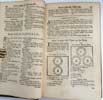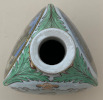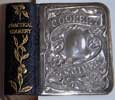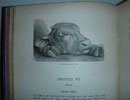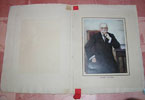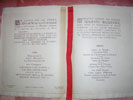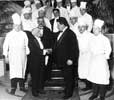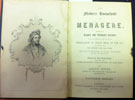La Cave du Restaurant de la Pyramide
Fernand Point VIENNE (ISERE) TELEPHONE 0-96.
Measuring a large 19.5” x 12.5”. 4 pages. Yellow cardboard, with a drawn illustration of the Roman Pryamide in Vienne. The menu written in Mme Point’s typically large hand-writing on the front cover, with the inscription beside it, reading: Pour Monseur et Madame Read Mullam avec le hommages Gastronomiques de Fernand Point 26-9-53. The two inside pages with four large columns with wines listed and priced. The back page empty except for two photographs of Roman ruins of Vienne. It has previously been folded in the middle but now straightened and housed in a large cardboard and marbled folder with a label on the front cover. Nice and clean with minimal wear. A very rare collector’s item.
- Fernand Point (1897, Louhans, in Bresse in Saône-et-Loire, Burgundy–March 5, 1955) was a well-known French restaurateur in Vienne, a small city twenty miles south of Lyon, who for many years was the owner of La Pyramide, which was considered by many to be the greatest restaurant in the world. Although he died about twenty years before the introduction of what became known as nouvelle cuisine, he is nevertheless considered to be the father of modern French cuisine because of the numerous great chefs that he influenced and trained: his insistence on absolutely fresh ingredients for dishes of regional background (this is why the menus were written daily by Mme Point, only after Fernand had been to the market and decided on the day's dishes), and his refusal to use the old-fashioned made-in-advance sauces of 'haute cuisine'. His quest for perfection in everything he served led, in 1933, to his restaurant being among the first to be given the newly introduced three-star rating by the Michelin Guide. Such master French chefs as Paul Bocuse, Alain Chapel, and Jean and Pierre Troisgros trained under Point and, applying his principles, eventually helped create the nouvelle cuisine of the late 1970s. Born in Burgundy, Point was the son of a hotel-restaurant owner and during his youth trained in well-known restaurants such as Foyot and the Bristol Hotel in Paris, the Majestic in Cannes, and the Royal Hotel in Évian-les-Bains. In 1923 his father bought the hotel-restaurant Guieu in Vienne but died two years later. Point left his job at the Royal Hotel and took over the restaurant, which he renamed La Pyramide. With the help of his wife, Marie Louise, he would run it for the next 30 years. Five years after taking it over, he won his first star from Michelin and in 1933 La Pyramide was among the first twenty-three restaurants that received three stars, an accolade that it would retain for more than 50 years. It was again among the first seven three-star restaurants when, in 1951, this rating was resumed after the war. In 1955, the year of Point's death, there were 12 three-star restaurants, and his widow Marie Luise (who died 1986) managed to keep the restaurant in this top category. This is a special menu hand-written by Mme. Point on the La Pyramide wine menu. Checking the wine menu one can see that it is exceptional, with a very comprehensive selection. Among some of the many gems one can find is a Cotes-du-Rhone Hermitage 1870. A Chateau d’Yquem 1892. A Chateau-Lafitte Rothschild 1865. The Menu itself starts with one of the dishes Point was famous for: Brioche de Foie Gras.





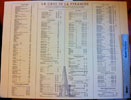
click on image to enlarge

Modern category
ref number:
11133 



